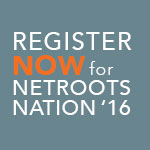After a great run, the Winning the Internet blog has been retired. However, you can still keep in touch with New Media Mentors here.

Rohan Porteous
As we get ready for Netroots Nation 2015, we’re taking a closer look at some of the convention’s most exciting training sessions. We’re interviewing the trainers and taking you inside some of online activism’s most popular and elusive topics.
Today we’re interviewing Rohan Porteous of Agency, who’ll be leading Creative for All: The Keys to Creating Compelling Content.
NN15 Training Session
Creative for All: The Keys to Creating Compelling Content
Come learn the basics for getting creative ideas up and running efficiently and in-house. We’ll cover everything from breaking down key messaging into a strong and sharable graphic image, to basic design principles to cheap creative tools that are available for anyone to use.
Interview
Q: Tell us about yourself and your design experience.
A: While I was studying design at university I became tired with the idea of doing ‘cool creative’ that simply sells products or builds corporate brands. (I also never got into Mad Men, which might be more due to disliking the sexism rather than disliking selling cigarettes, but still).
Deferring my final semester to figure it out led to an exciting if slightly haphazard few years… I got to satisfy my love for film at one of Melbourne’s largest production companies, learn digital at a small web design studio, and branch out on my own social impact projects in Rwanda, Papua New Guinea and some indigenous communities in Northern Australia.
But it wasn’t really until working at the Copenhagen climate conference, however, that I realized you could actually work in design at a company set on making a difference. (Who knew?) Skipping ahead, I’m now lucky enough to be the creative director of a team of 18 at Agency, a creative studio which aims to do just that.
At Agency I’ve had the privilege of working with organizations like World Vision, GetUp, Greenpeace, AllOut, UNDP and Amnesty International, on projects from rapid response micro-sites to multi-million dollar fundraisers and groundbreaking political campaigns.
This year we’ve set up shop in New York. And, fortunately for me, the Center for Social Innovation’s space in Chelsea isn’t Draper’s Madison Avenue — people are focused on making real change without a cigarette in sight.
It’s exciting to think about where we go from here, and I’m looking forward to seeing how we might help people and organizations on this side of the Pacific do good, better.
Q: In your opinion, what is the most common mistake that people make when designing graphics?
A: One of the most common mistakes people make when approaching design from a campaign perspective is considering the content and design separately.
In a world that is becoming increasingly content based there’s a high demand to engage with your audience across mediums. Email might be sticking around for a while yet, but campaigners should shift towards being visually literate communicators to create compelling content that rises above the rest.
Q: What are the two most important principles to keep in mind when doing design work?
A: Two very important design principles (that can be easy to forget) are:
- Ask why. It’s easy to believe that our gut instincts are right, but you need to get to the heart of your subjective preferences, why you approached something a certain way. The sooner you do that, the sooner you can empathize with your audience and understand how they might like to be approached.
- Understand hierarchy and visual flow. Our eyes dart through content, grabbing for that one cool post in our news feed, or desperately searching for the close button on the 5th annoying pop up you’ve seen in the last 20 minutes. Knowing how to visually guide people through your content not only helps with graphics, but with things like photography, websites, an email, or even your living room. Best part? They won’t even know you’re doing it.
Q: Why should folks attend your session at Netroots Nation, and how can they connect with you?
A: Come along to get the essential tips & tricks to becoming a visually literate communicator. The session will help you introduce more creative content into your organization’s work, and give your team some good resources to get started if you’d like to try it in-house.
You can find me on twitter at @rohjames if you have any specific requests for the session or if you’d like to chat during a break, and you can check out Agency at http://agency.sc / @agencysc.
To attend this training, or one of the 39 others at Netroots Nation 2015 in Phoenix, register now.




Comments are closed.